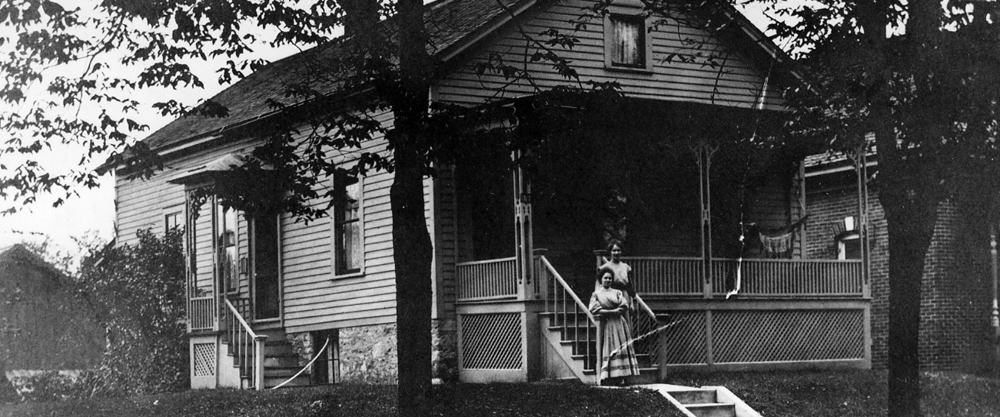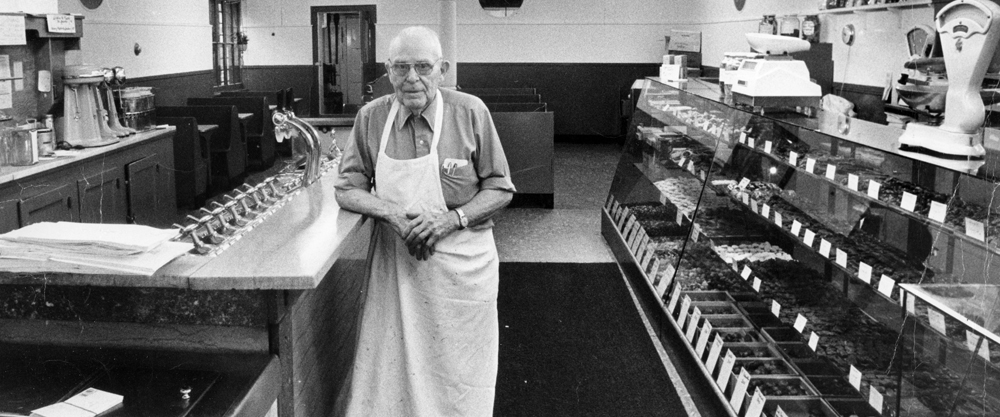Resources
—Neighborhoods—
The resources listed below are unique to this page, and fall under this general category. Browse the sub-categories in the pages listed above if you are looking for a resource that falls under a more specific topic.
Creator:
Baudhuin, Jason
Description:
Student paper-University of Wisconsin -- La Crosse, 1991.; "For Historiography 395...December 16, 1991"; Cover title.; Also available online.; Advisor: C. Lee; Includes bibliographical references.; At head of title: University of Wisconsin-La Crosse.
The Goosetown neighborhood covered the formerly residential area that was bounded on the north by the La Crosse River marsh; west by 12th Street North, the former interstate fairgrounds (Harring Field and Memorial Stadium to the east. The southern border is in dispute, ranging from the north side of Vine Street all the way to the north side of Main Street.
The Goosetown neighborhood covered the formerly residential area that was bounded on the north by the La Crosse River marsh; west by 12th Street North, the former interstate fairgrounds (Harring Field and Memorial Stadium to the east. The southern border is in dispute, ranging from the north side of Vine Street all the way to the north side of Main Street.
Author:
La Crosse Public Library Archives
Creator:
La Crosse Public Library Archives
Description:
Discover the history and architecture of La Crosse through the guided tours in this online resource.
Experience the development, beauty, and changing architectural styles of La Crosse from the boomtown riverboat days through the present. Learn about La Crosse's past - about the people and their stories.
Interested in seeing this architecture in person? Use the resources on the website to create your own self-guided tour, or join the La Crosse Public Library Archives in the spring and fall of each year during our historic walking tour events.
Author:
La Crosse Public Library
Creator:
La Crosse Tribune
Description:
Newspaper articles related to public school boundaries in La Crosse, Wisconsin, from 1949-2003. Changes in school boundaries have often sparked controversy among parents of school-aged children. Follow the changes since 1949, read about the beginning of the neighborhood school concept in 1971, the 1979 controversy of redrawing the line for high school attendance in the district, the progressive socio-economic balancing goals in 1991-1992, and the need again in 2002 to provide socio-economic balance and diversity among the elementary population.
Author:
University of Wisconsin-La Crosse Oral History Program
Description:
Albert E. Flottmeyer discusses his life in La Crosse, Wisconsin, focusing on his experiences and observations as a building developer. He details the housing industry, describing construction materials, building styles, interior design, and housing developments, in particular the Wedgewood Terrace and Wedgewood Valley developments.
Author:
University of Wisconsin-La Crosse Oral History Program
Description:
Feinberg discusses his life in La Crosse, Wisconsin. He describes his work history, including starting his own business, Sanitary Supply Company. He details the development of downtown La Crosse and discusses organizing the 3rd Street Merchant's Association. He also describes the Market Square complex and changes in the downtown shopping area.
Author:
University of Wisconsin-La Crosse Oral History Program
Description:
Pat Seubert (b. 1936) discusses her life in La Crosse, Wisconsin. She focuses on family and neighborhood life and details recreation activities and social life. She also describes changes in society and politics during her lifetime. Topics includ but are not limited to: childhood home, La Crosse neighborhoods, 20th century changing technologies (dishwasher, washing machine), household roles, husband's employment, raising a family, clothing fads, leisure activities, children's extracurricular activities and music tastes, fraternal and social organizations, courtships and friendships, treatment of women (1940s-1970s), relationship and marriage (married 1958), vacations and first car, WWII (homefront), Communism, Korean War, nursing homes and funerals, religious importance, major societal changes (1945-1960s), family ethnicities, and racial and ethnic tensions in La Crosse. Content warning: this interview does contain racist, anti-Black language.
Tape 2
Author:
University of Wisconsin-La Crosse Oral History Program
Description:
In this interview, Paul Cuta and Alberta (Cuta) Gund primarily discuss German and Czech culture during the early 20th century in La Crosse. Topics include but are not limited to: the family home (1016 Farnam Street), Bohemian (Czech) traditional names, Catholicism, parental roles, cigar making, commercial fishing, wooden boat building, Funke's Candy Company, gardens and growing vegetables, paternal grandparents, life in the family home, Hood-Powell Park neighborhood, religious divisions in town; German-Lutheran, German-Catholics, Bohemian-Catholics, Irish-Catholics, Holy Trinity Parochial School, activities at schools, fundraisers, sports, dancing, traditional Bohemian (Czech) food, World War II, La Crosse Tribune, fashion, war rations, street cars, Protestant and Catholic neighborhood relationships, The Strand Theater, recreation activities, school yard games, home remedies, Powells Park, Lapitz Grocery Store, shoe stores and cobblers, home funerals, Hammes Grocery Store, Bruha Selrite Grocery Store, Aboto's Confectionary, bicycling in 1940s, communications during Korean War, home-brew alcohol served in Bohemian Hall, Humms Bakery, Tabbert's Dry Goods Store, taverns, gasoline industry, Tomicek Car Service, financial loans, soap rations during WWII, Baum's Butcher Shop, Shimshack's Shoe Repair and Tavern, Not Your Uncle's Tavern, and the Prohibition era.
Tape 2
Tape 2
Author:
University of Wisconsin-La Crosse Oral History Program
Description:
Hackner discusses his life in La Crosse, Wisconsin, where he became an architect's apprentice and after establishing his own business in 1953, worked on commercial and residential buildings. He details his involvement in the development of the first public housing projects in La Crosse in 1957 and also discusses La Crosse architectural developments in the 1950s.
Author:
University of Wisconsin-La Crosse Oral History Program
Description:
Mr. Rynning discusses the following topics: Personal history, 1900s -- Family Norwegian ancestry, Direct decent of Bishop Bech crowning Norwegian King 1818 -- Immigration from Norway, 1870s -- Surname spelling and pronunciation change -- paternal immigration, 1876, civil engineering degree from Sweden -- Fathers career at Holway Lumber, La Crosse, Wisconsin; Rynning and Pedrson Clothing store, 727 Rose Street, La Crosse, Wisconsin; Exchange State Bank, La Crosse, Wisconsin 1892 -- Fathers death, Dr. Adolf Gundersen performed surgery, 1895 -- Statement to La Crosse paper, Allegations against Gundersen for malpractice 1895 -- Brothers civil engineer degree, University of Wisconsin-Madison, accident in St. Louis, death in 1909 -- Attempt to deferral from draft, World War One (1915-1918) -- Drafted into World War One (1915-1918): July 8, 1918, Promotion to Sargent: September 15, 1918 -- Left position at Exchange State Bank, 1920, reasoning due to hiring cheap labor after WWI -- W.A. Roosevelt Company, employment, 1920-1953 -- Fathers memories of La Crosse, Wisconsin, 1880s to 1890s -- Ballard Drug Store, 3rd and Pearl Street, La Crosse, Wisconsin -- Maternal immigration, Norway, 1870s -- Fathers education, language; German, French, English, Norwegian, Swedish, Finnish -- Holway Lumber Mill, St. Cloud Street, La Crosse, Wisconsin -- Union National Bank, Main and 4th Streets, La Crosse, Wisconsin -- Making currency exchange, transporting $10,000 through town, carried gun for insurance -- Union National Bank, staff picture, 1911 -- North side neighborhood living, La Crosse, Wisconsin, 1922 -- Black River, swimming with neighborhood kids, 1910s.
Tape 2
Tape 3
Tape 4
Tape 2
Tape 3
Tape 4
Author:
University of Wisconsin-La Crosse Oral History Program
Description:
Sylvan Arthur Schonsberg discusses his family background and life in La Crosse, Wisconsin. Topics include but are not limited to: 1965 Flood, hardware stores, Burlington Train Depot, WWII, entertainment (Avalon Ballroom, Riviera Theatre, Oktoberfest, Farm Fest fair, parades, Torchlight Parade), flea market, rivalry between Logan and Central High Schools, household appliances, stores in downtown La Crosse.
Author:
University of Wisconsin-La Crosse
Creator:
Johnson, Gena
Description:
The focus of this project is an examination of a house eligible to be recognized on
the National Register of Historic Places, located at 1328 State Street in La Crosse,
Wisconsin. The project discusses Victorian architecture as applied to family homes
in La Crosse. This study pays further attention to the style of architecture known as
the Queen Anne as it is seen at the house at 1328 State. This subject also includes
the genealogy of the historic structure and examinations of its changes in architecture
as a result of changes in the social conditions of La Crosse. Included in the
genealogy is an examination of the residents of the house, starting with the
Schilling family and leading to the current occupancy of the house by a UW-La
Crosse sorority, Alpha Xi Delta.
Published as part of the University of Wisconsin-La Crosse Journal of Undergraduate Research, Volume 5 (2002)
Published as part of the University of Wisconsin-La Crosse Journal of Undergraduate Research, Volume 5 (2002)
Author:
University of Wisconsin-La Crosse
Creator:
University of Wisconsin-La Crosse public history class
Description:
In September of 2003, UW-La Crosse history professor Charles "Chuck" Lee, approached the Washburn Neighborhood Association, offering to work on a project for the association. As a result of that offer, Professor Lee's Public History class was tasked with preparing historic sites nominations, developing a walking tour of the neighborhood, and conducting neighborhood oral history interviews.
Author:
University of Wisconsin-La Crosse
Creator:
Boesel, Terri
Description:
The Powell-Hood Park-Hamilton Neighborhood Steering Committee's plans for revitalizing their neighborhood, while focusing on major physical issues like housing and facilities, include history. Recognizing that the present and the past are closely associated in vibrant communities, the steering committee called for a greater awareness of neighborhood history. In the fall of 1998, Professor Charles Lee of the University of Wisconsin-La Crosse Department of History, proposed the idea of compiling a neighborhood history to our public history class. Early in the school year we met with two of the steering committee members, Sandy Herold and Margaret Larson. They brought with them a list of ten people whom the committee had decided might have interesting information about the neighborhood. The members of the class divided up those ten people and interviewed them. With the help of those ten people, the class found fourteen more names, and these people were interviewed as well. The goal of this project was to help gather and record the history of the neighborhood through the eyes of its residents.




